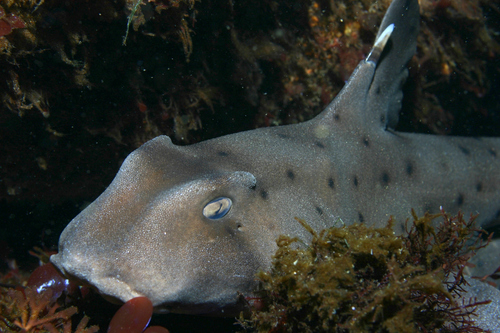
Horn Shark
The Atlantic Bluefin Tuna (*Thunnus thynnus*) is a magnificent and highly migratory species of tuna found in the Atlantic Ocean. Renowned for its size, speed, and commercial value, this apex predator plays a crucial role in the marine ecosystem.
12 25 years
Lifespan
97 - 120 cm
Length
Least Concern
Conservation Status
3 km/h
Swimming speed
Carnivorous
Diet
Local Migration
Migration
Appearance Overview
The Atlantic Bluefin Tuna is a large, powerful fish with a streamlined, torpedo-shaped body built for speed and endurance.
Coloration
Dark metallic blue above and silvery white below, providing camouflage from above and below.
Fins
Two dorsal fins, the first depressible into a groove; small, yellow finlets running from the second dorsal and anal fins to the tail.
Body Shape
Torpedo-shaped and robust, designed for efficient swimming.
Length
Commonly up to 6.6 feet (2 meters), but can reach up to 13 feet (4 meters).
Weight
Typically around 550 lbs (250 kg), but can reach over 1,500 lbs (680 kg).
Diet
Carnivorous, feeding on a variety of fish (such as mackerel, herring, and hake), squid, and crustaceans.
Feeding Behavior
Highly active predator that uses its speed and agility to hunt. They often hunt cooperatively, corralling prey into tight formations before striking.
Social Behavior
Forms schools, especially when young. Schooling behavior can vary with size and age, with larger individuals sometimes found alone or in smaller groups. They are highly migratory.
Commercial Relevance
Extremely high value, particularly in sushi and sashimi markets, where its fatty flesh is considered a delicacy. This high demand drives its economic importance.
Conservation measures
Management measures include fishing quotas, size limits, and time/area closures. International cooperation is crucial, involving organizations like ICCAT (International Commission for the Conservation of Atlantic Tunas).
Status
Varies by population segment; the Western Atlantic stock is considered to be recovering. Overall, the species is conservation-dependent, requiring careful management to prevent overfishing.
Threats
Overfishing is the primary threat, driven by high market demand. Other threats include bycatch in fisheries targeting other species and habitat degradation.
Habitat Distribution
Depth Range
Typically found from the surface to depths of 1,600 feet (500 meters), but can dive deeper, even exceeding 3,300 feet (1,000 meters).
Geographic Range
Found throughout the North Atlantic Ocean, including the Mediterranean Sea. Two main spawning grounds are recognized: the Mediterranean Sea and the Gulf of Mexico.
Preferred Environment
Prefers temperate and subtropical waters. They are pelagic, meaning they live in the open ocean rather than near the seabed.
Reproduction and Life Cycle
Breeding Habits
Spawns in warm waters, with two known major spawning grounds: the Mediterranean Sea and the Gulf of Mexico. Spawning typically occurs during specific seasons, varying by location.
Development Stages
Eggs hatch into larvae that drift as plankton. Juveniles grow rapidly, feeding on smaller organisms. They progress through several life stages before reaching adulthood.
Fecundity
Highly fecund; a single female can release tens of millions of eggs per spawning season. The exact number depends on the size and condition of the female.
Maturity Age
Reaches sexual maturity at different ages depending on the population. Western Atlantic stock typically matures around 8-12 years, while the Eastern Atlantic stock matures earlier, around 4-5 years.
Faqs about Horn Shark
How long do Atlantic Bluefin Tuna live?
Atlantic Bluefin Tuna can live up to 40 years, although this is becoming increasingly rare due to fishing pressure.
How fast can Atlantic Bluefin Tuna swim?
They are among the fastest fish in the ocean, capable of bursts of speed up to 43 mph (70 km/h).
Are Atlantic Bluefin Tuna warm-blooded?
Yes, they are warm-blooded, unlike most fish. They have a specialized circulatory system that allows them to maintain a body temperature higher than the surrounding water, aiding in muscle efficiency.
Do they migrate?
Atlantic Bluefin Tuna undertake extensive migrations across the Atlantic Ocean, often traveling thousands of miles for feeding and spawning.
What is ICCAT?
ICCAT is the primary international body responsible for the conservation and management of Atlantic Bluefin Tuna and other tuna species in the Atlantic Ocean.
Copyright @ Nature Style Limited. All Rights Reserved.
 English
English